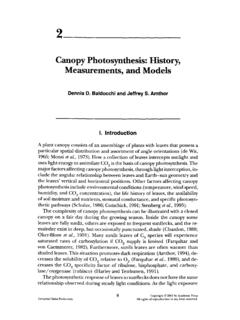Transcription of A Solar Hot Water Sizing and Payback Calculator: an ...
1 Ryan McCarter Solar Hot Water Sizing and Payback calculator Spring 2011 1 A Solar Hot Water Sizing and Payback calculator : an innovation based on hot Water consumption models Ryan McCarter ABSTRACT Solar hot Water heaters can provide a significant fraction of the residential energy budget. However, to do so, the Solar hot Water industry must overcome barriers hindering adoption rates. This paper addresses two such barriers with the development of a calculator to allow interested residents to accurately estimate system size and financial Payback of Solar hot Water heaters based on their average daily hot Water consumption.
2 The first barrier to residential hot Water usage is the general lack of awareness of individual energy needs and how they can be met most economically. In using this calculator , residents will begin to see how they can save significantly on Water heating costs and how their hot Water consumption affects these costs. To remedy a second market barrier, this calculator enables residents to accurately assess the Solar collector area needed for their specific hot Water demand. Presently, installations of oversized Solar hot Water heaters have impaired financial returns and could tarnish the Solar industry if left unchecked.
3 Many existing calculators have attempted to spread awareness through system size and financial calculations but fail to predict them accurately. My calculator adds unparalleled accuracy over existing calculators and is the first time a detailed hot Water use model is used to estimate collector area and Payback period. My calculator is applicable to a broad range of geographic locations, but in this paper, I assessed its accuracy in residential homes in Berkeley, Ca. KEYWORDS Payback period, collector area, hot Water use, residential hot Water demand, natural gas Ryan McCarter Solar Hot Water Sizing and Payback calculator Spring 2011 2 INTRODUCTION In recent years, the depletion of conventional energy sources, such as coal and oil, and their adverse impact on the environment have created a growing demand for the application of renewable energy.
4 Replacing conventional fossil fuels with renewable energy significantly reduces greenhouse gas emissions and other environmental harms, such as air pollutant emissions, acid rain, and invasive resource extraction practices ( DOE, 2003). Acknowledging the need for both renewable and cleaner fuels, states, such as California, are leading the way to renewable energy independence (Ghanadan & Koomey, 2005). For instance, California s Senate Bill 1, the California Solar Initiative, provides for the allocation of government rebates to encourage the use of Solar technology and to combat climate change (Fuller, Kammen, & Portis, 2009).
5 Solar hot Water heaters (SWH) represent one such Solar technology capable of cutting significant greenhouse gas emissions. As a well-developed, renewable technology and relatively low-tech system, Solar Water heating (SWH) systems provide an efficient method for using the sun s energy to heat Water ( DOE, 2003). Unlike traditional natural gas heaters, SWH systems source the majority of the energy needed to heat Water from the sun (Hughes, 2009). This free energy from the sun significantly cuts down on natural gas consumption, as sunlight displaces natural gas as an energy source.
6 In the state of California, if 80 percent of its residential hot Water were sourced from SWH systems, California could potentially reduce its carbon dioxide equivalent (CO2e) by million metric tons per year, or the equivalent of the pollution emitted by million cars annually (Del Chiaro & Telleen-Lawton, 2007). This reduction in emissions represents about 5 percent of the cuts necessary to meet California s Assembly Bill No. 32 target for reducing greenhouse gas emissions to 1990 levels by 2020 (Del Chiaro & Telleen-Lawton, 2007).
7 Thus, SWH systems are carving a niche in the energy market specifically, the residential hot Water market, which accounts for 20 percent of total energy use in the residential sector ( EIA, 2005). Although a technologically and environmentally feasible option, SWH system s economic feasibility remains largely unknown to residential populations (Sinha & Tiwari, 2007). Despite the verity that virtually any building with a sun exposed roof can have Solar hot Water and take advantage of notable savings on annual heating costs, fewer than one percent of California buildings have systems installed (Del Chiaro & Telleen-Lawton, 2007; Frantzis, Ryan McCarter Solar Hot Water Sizing and Payback calculator Spring 2011 3 Goffri, Paidipati, Sawyer, & Moffat, 2010).
8 The basis for this under adoption of SWH technology is two-fold. First, hot Water heating remains one of the least apparent uses of energy consumption in the home, overshadowed by more obvious uses of energy, such as space heating, air conditioning, and lighting (Fitzmorris, 2010; Margolis & Zuboy, 2006; Mayer, 1999; Zuboy, 2006). Residents continue to be naive to the factors affecting their hot Water heating bill, such as age of residents in their home, choice of appliances, and Water heater temperature setting.
9 Additionally, the economic reward that Solar hot Water heating has over conventional natural gas heating goes unnoticed. Second, because industry contractor compensation increases with project size, consumers often purchase systems oversized for their hot Water needs (Fitzmorris, 2010; Hirshberg & Schoen, 1974; Margolis, 2006). Unlike Solar photovoltaic systems, SWH s cannot sell unused energy back to the grid. Consequently, any oversized system results in an over investment without means to recoup the loss.
10 To aid adoption of SWH technology, the Solar industry has attempted to spread awareness of the economic value of installing SWH systems by providing consumers with calculators for estimating system size and Payback periods. However, the current calculators are oversimplified and give inaccurate estimates of residential hot Water consumption. Because system size and subsequently Payback periods are calculated based on Water consumption, more accurate estimation models are imperative. To address the residential market impediments and the Water consumption inaccuracy of existing calculators, I constructed a collector area and Payback calculator using a detailed estimation model incorporating residential hot Water use patterns developed by the Lawrence Berkeley National Laboratory (Lutz, Xiaomin, McMahon, Dunham, & Shown, 1996).



















